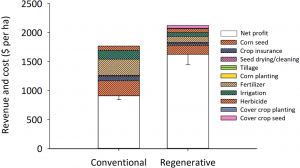It continues to create a buzz.
Regenerative fields have higher profits than conventional fields.
Regenerative farming on BBC Springwatch.
.
These pages have already looked at the idea of “moving away from sustainable agriculture’s aims “to reduce or do no harm” or “apply fewer chemicals” towards an approach where “restoring”, “improving” and “providing benefits” are the focus”:
Regenerative agriculture – Vision Group for Sidmouth
.
This is from a piece by professor of geomorphology David R Montgomery from last summer:
“I find it fitting that the words humus and human share the same Latin root, restoring healthy soils is the best investment we can make in humanities future. So as we grapple with the daunting problems of feeding the world and cooling the planet, let us not lose sight of a simple truth. Sometimes the answers we seek are right beneath our feet!”
Growing a Revolution incentivise soil health with subsidies – Agri-TechE
.
And this is from earlier in the year, with further words from Prof Montgomery:
Regenerative agriculture continues to create a buzz. With its potential to drive down production costs, improve margins and increase soil health, no wonder it is being welcomed with open arms by many farmers, supply chains and policymakers…
 Headline results
Headline results
- Regenerative fields had 29% lower grain production but 78% higher profits than the conventional fields
- The profits were largely driven by input savings (fertiliser, pesticides and fuel)
- Profit was positively associated with the particulate organic matter of the soil, but not yield
Figure 1. Revenue and costs for US corn production – ‘conventional’ v ‘regenerative’ system. Source: LaCanne, C. E., Lundgren, J. G. 2018. Regenerative agriculture: merging farming and natural resource conservation profitably. Peer, J. 6:e4428 doi.org/10.7717/peerj.4428
“It is certainly feasible that all farmers across the world could use all three principles of regenerative agriculture successfully by 2050. This era will become the new conventional agriculture, with the old approach potentially referred to as high-input Palaeo agriculture.”
Stepping forward into regenerative agriculture | AHDB
.
Regenerative agriculture is indeed creating a buzz: these articles are from the last week:
Ag Report: Regenerative agriculture explained
Arable: Regenerative farming – groundbreaking or greenwashing? | The Scottish Farmer
How grassland farmers are tackling the climate and biodiversity crisis head on | The Scottish Farmer
.
Meanwhile, BBC One’s Springwatch has been on an estate in Norfolk:
Presenters Chris Packham and Michaela Strachan will be broadcasting from Wild Ken Hill, where thousands of acres of farmland, woodland, heath and wetland are being given back to nature.
The estate, which stretches from The Wash north of Snettisham as far inland as Sedgeford, is pioneering an approach where rewilding and reintroducing beavers and native breeds of cattle works alongside regenerative agriculture to restore the landscape.
Dominic Buscall, project manager at Wild Ken Hill, said: “Its an opportunity to take our approach to a prime time audience. It includes rewilding, it’s also about regenerative farming. And it’s also about showing a bigger audience there is hope for nature to recover.”
Springwatch 2021: Behind scenes at Wild Ken Hill in Norfolk | Eastern Daily Press